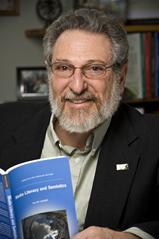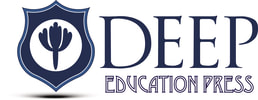The analysis of signs and symbols pertains to the field of semiotics, the science of signs. Semiotics is the study of semiosis or sign action; it can describe any process that includes the production of meaning, whether linguistic or not. Thus semiosis defines the process of making meaning as mediated by signs and the interpretation of those signs. Curricula constitute applied semiotics for the purpose of Education; their enactments lead to educational semiosis. Significantly, teachers’ awareness of semiosis generates metasemiosis, as their engagement in such deep reflection stimulates conceptual reframing, which can be qualified itself as a trans-semiotic process. Semiotics becomes educational when it is used for a purpose.

Book Editor
Dr. Gary Shank
Professor, Educational Foundations and Leadership
Duquesne University, Pittsburgh, Pennsylvania
shank(at)duq.edu
Dr. Gary Shank is a Professor of Educational Research at Duquesne University in Pittsburgh, PA. He has been active in semiotics since 1979, when he attended his first Semiotic Society of America meeting at his alma mater, Indiana University. He has been active in semiotics and educational research and semiotics since then. He was a founding member and Past-President of the Semiotics in Education SIG at the American Educational Research Association (AERA). He has published in Semiotica and the American Journal of Semiotics. He has been a plenary speaker for the Biosemiotics Convening, where he talked about the Semiotics of PS 101. He has also published extensively in qualitative research, where he has authored or co-authored three related books. In this Educational Semiotics book series titled Signs & Symbols in Education, Dr. Shank is looking for visionary works on education and semiotics and how they can reinforce and build from each other.
Dr. Gary Shank
Professor, Educational Foundations and Leadership
Duquesne University, Pittsburgh, Pennsylvania
shank(at)duq.edu
Dr. Gary Shank is a Professor of Educational Research at Duquesne University in Pittsburgh, PA. He has been active in semiotics since 1979, when he attended his first Semiotic Society of America meeting at his alma mater, Indiana University. He has been active in semiotics and educational research and semiotics since then. He was a founding member and Past-President of the Semiotics in Education SIG at the American Educational Research Association (AERA). He has published in Semiotica and the American Journal of Semiotics. He has been a plenary speaker for the Biosemiotics Convening, where he talked about the Semiotics of PS 101. He has also published extensively in qualitative research, where he has authored or co-authored three related books. In this Educational Semiotics book series titled Signs & Symbols in Education, Dr. Shank is looking for visionary works on education and semiotics and how they can reinforce and build from each other.
Advisory Editorial Board

Dr. Farouk Y. Seif
Executive Director of the Semiotic Society of America
Visiting Faculty, Organization Systems Renewal
Seattle University
fseif(at)antioch.edu
Founding Director of Isis Institute
Professor Emeritus, Whole Systems Design Program, Co-founder, Center for Creative Change at Antioch University Seattle, Washington
Executive Director of the Semiotic Society of America
Visiting Faculty, Organization Systems Renewal
Seattle University
fseif(at)antioch.edu
Founding Director of Isis Institute
Professor Emeritus, Whole Systems Design Program, Co-founder, Center for Creative Change at Antioch University Seattle, Washington

Dr. Elliot Gaines
Professor of Communication at Wright State University
Current President of the Semiotic Society of America
Fellow of the International Communicology Institute
elliot.gaines(at)wright.edu
Dr. Elliot Gaines's research is focused on media, culture, communication, and semiotics. Gaines’ book, Media Literacy and Semiotics (Palgrave Macmillan 2010) provides methods and applications of semiotics to analysis of media entertainment, news, and advertising, offering insight into audiences, identity, time, space, myth, and ideology. Before entering academic life, Gaines had more than 20 years in performance, media production, advertising, public relations, and work as a music therapist.
Professor of Communication at Wright State University
Current President of the Semiotic Society of America
Fellow of the International Communicology Institute
elliot.gaines(at)wright.edu
Dr. Elliot Gaines's research is focused on media, culture, communication, and semiotics. Gaines’ book, Media Literacy and Semiotics (Palgrave Macmillan 2010) provides methods and applications of semiotics to analysis of media entertainment, news, and advertising, offering insight into audiences, identity, time, space, myth, and ideology. Before entering academic life, Gaines had more than 20 years in performance, media production, advertising, public relations, and work as a music therapist.

Dr. Brooke Williams Deely
2009-2012 Director, Women, Culture, and Society Program
Taught in Honors Program and in the Philosophy Department
Currently teaches in two graduate programs at the
University of St. Thomas, Houston
jndeely(at)stthom.edu
Dr. Brooke Williams Deely taught semiotics courses at Indiana University and at Universidade de Minas Gerais in Brazil. Her monograph History and Semiotic is a Toronto Semiotic Circle Publication. Her article, “History and Semiotics in the 1990s”, appeared in Semiotica 83 (3/4), 385–417. For Thomas A. Sebeok she wrote the prefatory essay, "Challenging Signs at the Crossroads", for the reprinting of his seminal book, Contributions to the Doctrine of Signs, and co-edited the anthology Frontiers in Semiotics (IUP). She is editor of Pope John Paul II Speaks on Women (CUA Press, Fall 2014).
2009-2012 Director, Women, Culture, and Society Program
Taught in Honors Program and in the Philosophy Department
Currently teaches in two graduate programs at the
University of St. Thomas, Houston
jndeely(at)stthom.edu
Dr. Brooke Williams Deely taught semiotics courses at Indiana University and at Universidade de Minas Gerais in Brazil. Her monograph History and Semiotic is a Toronto Semiotic Circle Publication. Her article, “History and Semiotics in the 1990s”, appeared in Semiotica 83 (3/4), 385–417. For Thomas A. Sebeok she wrote the prefatory essay, "Challenging Signs at the Crossroads", for the reprinting of his seminal book, Contributions to the Doctrine of Signs, and co-edited the anthology Frontiers in Semiotics (IUP). She is editor of Pope John Paul II Speaks on Women (CUA Press, Fall 2014).

Dr. Ronald C. Arnett
Chair and Professor
Department of Communication & Rhetorical Studies,
Duquesne University
arnett(at)duq.edu
Henry Koren, C.S.Sp., Endowed Chair for Scholarly Excellence; Executive Director, Pennsylvania Communication Association ; Executive Director, Eastern Communication Association; Editor, Journal of Communication and Religion, Pittsburgh, Pennsylvania
Chair and Professor
Department of Communication & Rhetorical Studies,
Duquesne University
arnett(at)duq.edu
Henry Koren, C.S.Sp., Endowed Chair for Scholarly Excellence; Executive Director, Pennsylvania Communication Association ; Executive Director, Eastern Communication Association; Editor, Journal of Communication and Religion, Pittsburgh, Pennsylvania

Dr. Victoria N. Alexander
Director and co-founder, Dactyl Foundation
alexander(at)dactyl.org
Victoria N. Alexander's research interests include narrative theory, philosophy of science, and poetics. As a visiting researcher at the Santa Fe Institute (2000-2002), she studied evolutionary theory, teleology, complexity science and the role of meaning and creativity in complex emergent systems. She published The Biologist's Mistress: Rethinking Self-Organization in Art, Literature, and Nature (Emergent Publications) based on this research. She is also a novelist and is currently on the editorial boards of Meaning Systems books series (Fordham UP) and Biosemiotics (Springer UP).
Director and co-founder, Dactyl Foundation
alexander(at)dactyl.org
Victoria N. Alexander's research interests include narrative theory, philosophy of science, and poetics. As a visiting researcher at the Santa Fe Institute (2000-2002), she studied evolutionary theory, teleology, complexity science and the role of meaning and creativity in complex emergent systems. She published The Biologist's Mistress: Rethinking Self-Organization in Art, Literature, and Nature (Emergent Publications) based on this research. She is also a novelist and is currently on the editorial boards of Meaning Systems books series (Fordham UP) and Biosemiotics (Springer UP).

Dr. W. John Coletta
Professor of English
University of Wisconsin-Stevens Point, Stevens Point, USA
jcoletta@uwsp.edu
A former President (2010) and Vice President (2009) of the Semiotic Society of America—as well as a former System Fellow at the Center for 21st Century Studies at the University of Wisconsin-Milwaukee (2010-2011 academic year) and at the Institute for Research in the Humanities at the University of Wisconsin-Madison (1999-2000 academic year)—Professor Coletta has research interests and publications in Peircean semiotics; the work of Umberto Eco; physio-, eco-, and biosemiotics; ecocriticism and postmodernism; the history and representation of ecological and evolutionary thought; the major British poet and minor naturalist John Clare; Samuel Taylor Coleridge and his theory of the symbol; and posthumanism and “critical animal studies.” Professor Coletta sits on the Editorial Board of The American Journal of Semiotics.
Professor of English
University of Wisconsin-Stevens Point, Stevens Point, USA
jcoletta@uwsp.edu
A former President (2010) and Vice President (2009) of the Semiotic Society of America—as well as a former System Fellow at the Center for 21st Century Studies at the University of Wisconsin-Milwaukee (2010-2011 academic year) and at the Institute for Research in the Humanities at the University of Wisconsin-Madison (1999-2000 academic year)—Professor Coletta has research interests and publications in Peircean semiotics; the work of Umberto Eco; physio-, eco-, and biosemiotics; ecocriticism and postmodernism; the history and representation of ecological and evolutionary thought; the major British poet and minor naturalist John Clare; Samuel Taylor Coleridge and his theory of the symbol; and posthumanism and “critical animal studies.” Professor Coletta sits on the Editorial Board of The American Journal of Semiotics.

Dr. Charls Pearson
Academic Ambassador to China for Logic, Semiotics,
Philosophy of Science, and Peirce Studies
Director of Research for American Semiotics Research Institute
dr.charls(at)avillager.org
Professor Pearson received the first Ph.D. in semiotics granted by an American university. He is a founding member of the Semiotic Society of America, a past member of its Executive Committee, and the founder of three of its Special Interest Groups: Special Interest Group for Empirical Semiotics (SIG/ES); Special Interest Group for Semiotics in the Southeast (SIG/SE); and Special Interest Group for Semiotics of Theology and Religion (SIG/STAR). He is a member of the American Society for Information Science and a founder of its Special Interest Group for The Foundations of Information Science. He specializes in the experimental, theoretical, and mathematical foundations of semiotics; and also applies semiotics to language, logic, music, and law.
Academic Ambassador to China for Logic, Semiotics,
Philosophy of Science, and Peirce Studies
Director of Research for American Semiotics Research Institute
dr.charls(at)avillager.org
Professor Pearson received the first Ph.D. in semiotics granted by an American university. He is a founding member of the Semiotic Society of America, a past member of its Executive Committee, and the founder of three of its Special Interest Groups: Special Interest Group for Empirical Semiotics (SIG/ES); Special Interest Group for Semiotics in the Southeast (SIG/SE); and Special Interest Group for Semiotics of Theology and Religion (SIG/STAR). He is a member of the American Society for Information Science and a founder of its Special Interest Group for The Foundations of Information Science. He specializes in the experimental, theoretical, and mathematical foundations of semiotics; and also applies semiotics to language, logic, music, and law.
